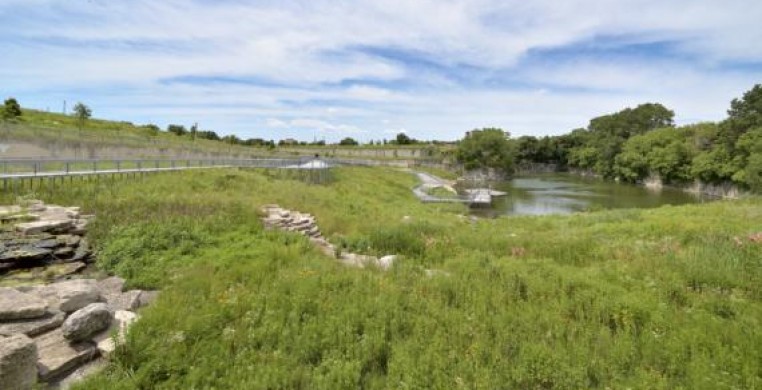Palmisano Park, formerly known as Stearns Quarry, is a 26.60-acre site on Chicago’s southwest side in the heart of the Bridgeport community. Its story is one of transformation, as it has changed from coral reefs to quarry to landfill to park. Not surprisingly, each incarnation played a major role in developing the next.
Take the Palmisano Park Audio Tour
This is a dynamic park, with a fishing pond, interpretive wetlands, preserved quarry walls, trails, an athletic field, a running track, and a hill that offers dramatic views. Over 1.7 miles of paths, including recycled timber boardwalks, concrete walks, a crushed stone running path, and metal grating walkways traverse the park. These trails allow for a variety of experiences along the quarry wall, across the terracing wetlands, and down to the pond. Scenic overlooks provide dramatic overviews of the pond and wetlands, and spectacular city views can be seen from the mound.
While there is no structured programming taking place at this location, we invite you to check out our great programs offered at nearby McGuane Park.
History
In 2009, this park was one of Chicago's newest and most interesting green spaces, opened in the Bridgeport neighborhood.
After convening community meetings to determine the needs of local residents, the Chicago Park District hired Site Design Group to develop a plan for the park. The environmentally-sustainable design was inspired by the natural history of the site.
This is the site of an ancient coral reef dating back to the Silurian age 400 million years ago. Dolomite limestone formed, and fossils that were found here are now in the collections of several area museums including Field Museum of Natural History.
In the late 1830s, the land was purchased by the Illinois Stone and Lime Company which began quarry operations. Within a short time, one of its partners, Marcus Cicero Stearns took over and renamed the quarry. Stearns was an early Chicago settler who got his start by opening a supply store for workmen who blasted out rock to build the Illinois and Michigan Canal.
Even after Stearns died in 1890, the quarry continued operating under his name until 1970. For the next few decades, the site was used as a landfill for clean construction debris. After the dumping ended, the idea of transforming the site into a new park emerged. The new park would be especially important because the surrounding Bridgeport neighborhood had long suffered from a lack of adequate green space.
Today, visitors to Palmisano Park can go fishing in a pond that retains old quarry walls; stroll along a wetland area that drains into the pond; watch for birds and other wildlife attracted by the site's vast range of native plants; fly kites in an open meadow; or take in the views of the cityscape.
Chicago Park District Project Manager Claudine Malik explains: “The Stearns Quarry of today has certainly come a long way from the days of a limestone quarry. The vibrant, active park is a welcome respite from city life, an educational opportunity, a place for recreation and a prime example of what creative thinking can accomplish and yet the memory of the quarry and its lasting historic legacy remain inextricably a part of the park.”
For directions using public transportation visit www.transitchicago.com.

